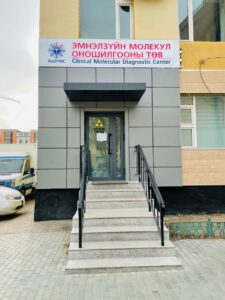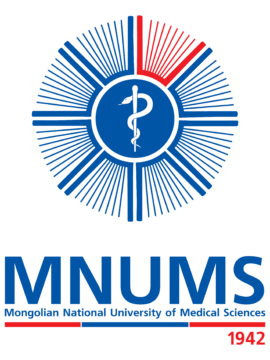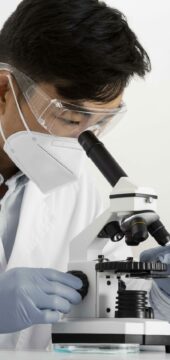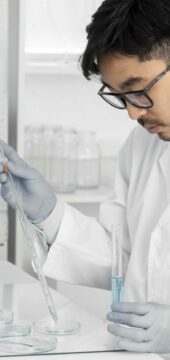Contact us
Clinical Molecular Diagnostic Center
Clinical Molecular Diagnostic Center
The Clinical Molecular Diagnostic Center of the MNUMS was established on April 1, 2021. Since its establishment, a team from the center with a high level of expertise has performed over 60,000 PCR tests for detecting SARS-CoV-2 virus infection from saliva and nasopharyngeal swabs with low cost and high quality during the two years of the pandemic.
Now, CMDC performs more than 30 clinical molecular diagnostic tests using modern equipment that meets internationally recognized quality standards and is the first to implement multiplex PCR analyses to detect bacterial, fungal species, and pathogenicity genes with up to 43 parameters for human microbiome analysis. As molecular biological analysis is considered one of the most sensitive and precise methods for diagnosing infectious and non-communicable diseases, our laboratory tests allow prompt treatment due to early detection of the disease at a stage that cannot detected by other tests and the ability to provide test results in a short time (<24 hours).
Quickly appropriate patient treatment could be provided by accurately identifying pathogens, which is crucial for efficient patient care. Multiplex PCR tests intended for DNA analysis of pathogenic and opportunistic bacterial and fungal infections, including 25 types of bacterial infection, 14 types of antibiotic resistance genes, and 14 types of fungal infection, improve patient care dramatically with nosocomial and community-acquired infections.
It is also essential in clinical practice to accurately diagnose infections with fastidious and unculturable pathogens such as H.pylori and anaerobic bacteria. The CMDC implemented H.pylori & ClariR Assay, which enables simultaneous detection and identification of Helicobacter pylori and three major mutations causing clarithromycin resistance using real-time PCR.
Human microbiome composition is a complex dynamic system, which at any given time is affected by many endogenous and exogenous factors, including age, diet, sexual behavior, hormonal status, hormonal disorders, antibiotic therapy, and the presence of other organ system pathology. The status of microbiome composition seriously impacts the maintenance of human health and, consequently, quality of life. The CMDC implements techniques to evaluate the human microbiome, including vaginal (up to 16 parameters), male genital (up to 24 parameters), and colon microbiome (up to 43 parameters) analysis through the detection of the normal flora, opportunistic, and pathogenic organisms. Female microbiome evaluation assay provides comprehensive data to analyze the amount of lactobacillus with the total amount of pathogenic, opportunistic bacteria, allowing evaluation of the evidence of microbiota disbalance. Fecal microbiome analysis designed to detect DNA of colon-associated microorganisms (Firmicutes, Proteobacteria, Bacteroidetes, Actinobacteria, Fusobacteria, Verrucomicrobia*, Euryarchaeota phyla), including Candida fungi, as well as a methicillin-resistance gene in Staphylococcus spp. (mecA), Cl.difficile with enterotoxins A and B genes (tcdA, tcdB), S. agalactiae invasiveness gene (srr2) by real-time PCR in DNA preparations obtained from feces samples for qualitative composition and quantitative assessment of large intestinal microbiota.
In 2021, 2022, and 2023, we have regularly and successfully participated in national and international external quality assessment programs organized by WHO, "Oneworld accuracy" from Canada and NCCD.

MISSION:
CMDC will introduce international standards, advanced diagnostic techniques, and technologies to healthcare services to support the implementation of state policies and directions to bring healthcare services to a new advanced level by providing reference-level molecular diagnostic services that other health institutions operating in Mongolia cannot carry out. Moreover, we aim to strengthen the human resources of the health sector through training activities and establishing a comprehensive diagnostic, training, and research center.


AREAS OF ACTIVITY:
- Infectious diseases and microbiome analysis (STDs, various infections of the respiratory and digestive tracts, meningitis, MDRO, etc.)
- Molecular diagnostic analysis of non-infectious diseases (cancer molecular markers, detection of gene mutations, differential diagnosis of acute and chronic diseases, other tests, etc.).
Research areas
Molecular diagnosis, molecular epidemiology, infectious disease diagnosis, non-communicable disease diagnosis, diagnostic molecular pathology. Microbiome, MDRO
Research Projects
Mongolian Center for Environmental, Occupational Health, component U01 and U2R NIH, USA (Investigator, supervisor of Aim 3) since 2022
This mentored research training program is prepare 25 Mongolian fellows for careers in environmental and occupational research with a goal of influencing Mongolian health policies. The center will have strengths in studying the interactions of air pollution and acute viral infections which are major problems in Mongolia. The training will advance multidisciplinary, environmental, and occupational health research collaborations between U.S. and Mongolian academic institutions. The goal of this Center is to develop independent, interdisciplinary, environmental and occupational health researchers. This U2R proposal outlines the training components of the Center. The twin U01 proposal outline the research components of the Center. Regarding U2R training, through a national search and a competitive process, we will screen and select five well-qualified Mongolian candidates for fellowship training each year. During the 15-months of formal training each Fellow will gain considerable training in conducting laboratory assays, the responsible conduct of research, research reproducibility, human and animal subjects research ethics, collecting field specimens. data analyses, delivering oral presentations, and in English language scientific writing. The collective expertise of the interdisciplinary Program Faculty committed to this Center will provide unique and valuable professional training for the Fellows and also greatly advance science at participating Mongolian institutions.
Use of serum aβ42 and p-tau biomarkers in the diagnosis of delirium following anesthesia, Ministry of Science and Education (advisor) since 2022
Postdoctoral grant “Use of blood plasma aβ42 and p-tau biomarkers in the diagnosis of cognitive decline after anesthesia” issued by the Ministry of Education and Science order dated September 28, 2022, No. A/367. This project will determine levels of Aβ42 and Tau proteins in human blood plasma among healthy patients without cognitive decline before anesthesia and patients with cognitive decline after anesthesia and determine diagnostic sensitivity and specificity of serum Aβ42 and Tau biomarkers.
HIV, syphilis integrated biological, behavioral surveillance in Mongolia, 2022 Global Fund (Principal Investigator) 2022-2023
This project is funded by the Global Fund (100,000 USD) and conducted in collaboration with the NCCD. A total of 1286 participants tested for HIV, syphilis by serological methods, and for C.trachomatis, T.vaginalis, N.gonorrheae, M.genitalum, U.urealyticum, M.homimus, U.parvum by PCR and the project report was successfully submitted.
Population size estimation of Female Sex Workers and men who have sex with men in Mongolia, 2022 Global Fund (Investigator) 2022
The team has received funding from the Global Fund on HIV Prevention Program for most at-risk populations, including Female Sex Workers (FSWs), Men who have Sex with Men (MSM), and transgender women (TGW). These key populations are high-risk groups for HIV infection and transmission. Understanding the prevalence of these populations’ situations and social characteristics is essential to planning a project work plan for a prevention and care program for the infected population. Network size was estimated by using six different research methods.
The National AIDS Spending Assessment (NASA) 2022 Global Fund (Investigator) 2022
Principal investigator L. Munkh-Erdene, MD, PhD, Professor. The team analyzed the funding for HIV and AIDS prevention and health care services by source, consumer, and service provider, expenditure of funds, production inputs, and beneficiary population. It calculated the expenditure of funds of the state, private sector, and donor organizations. Total budget – 23 million MNT.
Consumption of milk and dairy products and lactose intolerance MNUMS and APU dairy (Investigator) 2022
The Department of Nutrition of the School of Public Health, MNUMS, is collaborating to implement the project and the primary lactase deficiency associated with single nucleotide variants 13910 T>C and -22108 G>A) in a regulatory region of the LCT gene, MCM6 gene determined among study participants.
Study of the need for additional immunizations to determine the immune status against measles and rubella among women who are undergoing antenatal care WHO 2021/1133464-0 WPMNG2015959, 2021
However, immunization reduces measles outbreaks; periodic outbreaks have been reported in some areas over a while, depending on vaccine coverage and immunity against it. Therefore, according to the law on immunization, the serosurvey should be conducted every 4-5 years to monitor the immune status of measles and rubella among women of reproductive age to determine the need for additional immunization. The study determined the immune status against measles and rubella among women undergoing antenatal care from 13 study sites and 1,448 women who attended ANC for the first time during their pregnancy. Among pregnant women, 72.7 percent (n=1082) had a positive serology test for measles IgG. The overall prevalence of rubella IgG was 85.4% (n=1082).
Шинжилгээний Нэр Төрөл
"ОЭТББ"-ийг илрүүлэх ПГУ шинжилгээ
Мөөгөнцөрт халдварыг илрүүлэх шинжилгээ
1. ТВМ (нийт бактерийн масс)
2. Achromobacter ruhlandii
3. Achromobacter xylosoxidans
4. Acinetobacter spp
5. Burkholderia spp
6. Enterobacterales
7. Citrobacter freundii
8.Citrobacter koseri
9. Enterobacter cloacae
10.Escherichia coli
11.Klebsiella pneumonia+Klebsiella oxytoca
12.Klebsiella pneumoniae13.Morganella Morganii
14.Proteus spp
15.Serratia marcescens
16.Enterococuss spp
17.Haemophilus spp
18.Haemophilus influenzae
19.Pseudomonas aeruginosa
20.Staphylococcus spp
21.Staphylococcus aureus
22.Stenotrophomonas maltophilia
23.Streptococcus spp
24.Streptococcus agalactiae
25.Streptococcus pneumoniae
26.Streptococcus pyogenes
1.TBM (нийт бактерийн масс)
2.VAN A/B
3.MEC A
4.TEM
5.CTX-M-1
6.SHV
7.OXA-48-like
8.OXA-40-like
9.OXA-23-like
10.OXA-51-like
11.IMP
12.KPC
13.GES
14.NDM
15.VIM
1.Meyerozyma guilliermondii (C.guilli ermondii)
2.Candida albicans
3.Pichia kudriavzevii (C.kruseri)
4.Saccharomyces cerevisiae
5.Candida auris
6.Candida tropicalis
7.Clavispora lusitaniae (C.lusitaniae)
8.Debaryomyces hansenii (C.famata)
9.Candida dubliniensis
10.Candida glabrata
11.Candida parapsilosis
12.Malassezia spp
13.Malassezia furfur
14.Kluyveromyaces marxianus (C.Kefyr)
Sample intake control (SIC)
1.Candida albicans (CA)
2.Candida krusei (CK)
3.Candida glabrata (CG)
4.Candida dubliniensis (CD)
5.Candida parapsilosis, (CP),
6.Candida tropicalis (CTp),
7.Candida lusitaniae (CL)
H,pylori, кларитромициэы тэсвэржилтийг илрүүлэх ПГУ шинжилгээ
Бэлгийн замаар дамжих халдварыг илрүүлэх ПГУ шинжилгээ
1.H.pylori
2. Кларитромициний тэсвэржилтийн ген /23S rRNA мутаци нь 2143G, 2142G, 2142C/
1.Trichomonas vaginalis
2.Neisseria gonorrhoeae
3.Chlamydia trachomatis
4.Mycoplasma hominis
5.Mycoplasma genitalium
6.Ureaplasma urealyticum
7.Ureaplasma parvum
1.Trichomonas vaginalis
2.Neisseria gonorrhoeae
3.Chlamydia trachomatis
Хэвийн бичил биетэн, микробиотийг тодорхойлох ПГУ шинжилгээ
Вирусын халдварыг илрүүлэх ПГУ шинжилгээ
Total bacterial count
1.Lactobacillus
2. Enterobacteriaceae
3.Staphylococcus spp
4.Streptococcus spp.
5. Gardnerella vaginalis +Prevotella +Porphyromonas spp.
6. Eubacterium spp.
7.Sneathia spp. /+Leptotrichia spp. +Fusobacterium spp.
8.Megasphaera spp.+Veillonella spp. +Dialister spp
9. Lachnobacterium spp. +Clostridium spp.
10. Mobiluncus spp. +Corynebacterium spp.
11. Peptostreptococcus spp.
12.Atopobium vaginae
13.Candida spp.
14.Mycoplasma hominis
15.Ureaplasma (urealyticum +parvum)
16.Mycoplasma genitalium
Total bacterial count
1. Normoflora – Lactobacillus spp
2.Gardnerella vaginalis/ Prevotellabivia /Porphyromonas spp.
3. Mycoplasma hominis
4. Mycoplasma genitalium
5. Ureaplasma (urealyticum +parvum)
6. Candida spp.
7. Trichomonas vaginalis
8. Neisseria gonorrhoeae
9. Chlamydia trachomatis
10. Herpes simplex virus 1
11. Herpes simplex virus 2
12. Сytomegalovirus
Total bacterial mass (TBM)
1.Lactobacillus spp.
2.Staphylococcus spp.
3.Streptococcus spp.
4.Corynebacterium spp.
5.Gardnerella vaginalis
6.Atopobium cluster (Atopobium spp., Olsenella spp., Collinsella spp.)
7.Megasphaera spp. /Veillonella spp./ Dialister spp.
8.Sneathia spp. /Leptotrichia spp./ Fusobacterium spp.
9.Ureaplasma urealyticum
10.Ureaplasma parvum
11.Mycoplasma hominis
12.Bacteroides spp. /Porphyromonas spp./ Prevotella spp.
13.Anaerococcus spp.
14.Peptostreptococcus spp. /Parvimonas spp., Eubacterium spp.
15.Pseudomonas aeruginosa /Ralstonia spp./ Burkholderia spp.
16.Haemophilus spp.
17.Enterobacteriaceae family / Enterococcus spp.
18.Candida spp.
19.Mycoplasma genitalium
20.Trichomonas vaginalis
21.Neisseria gomorrhoeae
22.Chlamydia trachomatis
Total bacterial mass (TBM)
1.Lactobacillus spp.
2.Staphylococcus spp.
3.Streptococcus spp.
4.Corynebacterium spp.
5.Gardnerella vaginalis
6.Ureaplasma urealyticum
7.Ureaplasma parvum
8.Mycoplasma genitalium
9.Enterobacteriaceae family / Enterococcus spp.
10.Candida spp.
11.Trichomonas vaginalis
12.Neisseria gomorrhoeae
13.Chlamydia trachomatis
I. Хэвийн бичил биетний тоон үзүүлэлт
• Actinobacteria: Bifidobacterium spp., Coriobacteriia
• Firmicutes: Clostridium leptum gr., Dialister spp., Alisonella spp., Megaspherae spp., Veillonella spp. Faecalibacterium prausnitzii, Lachnospiraceae, Lactobacillaceae, Streptococcus spp., Lactococcus lactis
• Bacteroidetes: Alistipes spp., Bacteroides spp., Butyricimonas spp., Parabacteroides spp., Prevotella spp.
• Бусад бактер: Akkermansia muciniphila, Desulfovibrio spp., Methanobrevibacter spp.
• Нөхцөлт эмгэг төрөгч: Clostridium difficile gr., Clostridium perfringens, Enterobaterales, E.coli, Enterococcus spp., Erysipelotrichaceae, Fusobacteriaceae, Peptoniphilaceae, Pseudomonas spp., Staphylococcus spp.
• Мөөг: Candida spp., C.albicans
II. Хэвийн бичил биетний төрөл зүйлийн олон янз байдал;
III. Бифидобактер болон лактобациллийн тоо,
IV. Бифидобактерийн зүйлийн олон янз байдал (B.adolescentis, B. longum subsp.infantis, B. longum subsp.longum, B.bifidum, B.catenulatum subspp., B.animalis subsp.lactis, B.dentium, B.breve); V. Бактериодын илрэлтийн байдал (Bacteroidota/Bacteroidetes); VI. Bacillota/Bacteroidota харьцаа буюу Firmicutes/Bacteroidetes харьцаа,
VII. Эмгэг төрүүлэгч болон тэсвэржилтийн маркер: Clostridioides difficile tcdA, tcdB, Streptococcus spp., S.agalactiae (srr2), S.aureus (mecA)
1,FIuB
2,FluА
3,SARS-Cov-2
4,RSV
Herpes simplex-1
Herpes simplex-2
HPV types
High-risk (19 type)
1. HPV-16
2. HPV-18
3. HPV-26
4. HPV-31
5. HPV-33
6. HPV-35
7. HPV-39
8. HPV-45
9. HPV-51
10. HPV-52
11. HPV-53
12. HPV-56
13. HPV-58
14. HPV-59
15. HPV-66
16. HPV-68
17. HPV-69
18. HPV-73
19. HPV-82
Low-risk (9 type)
20. HPV-6
21. HPV-11
22. HPV-40
23. HPV-42
24. HPV-43
25. HPV-44
26. HPV-54
27. HPV-61
Бусад ПГУ шинжилгээ
Халдвар бус өвчний ПГУ шинжилгээ






